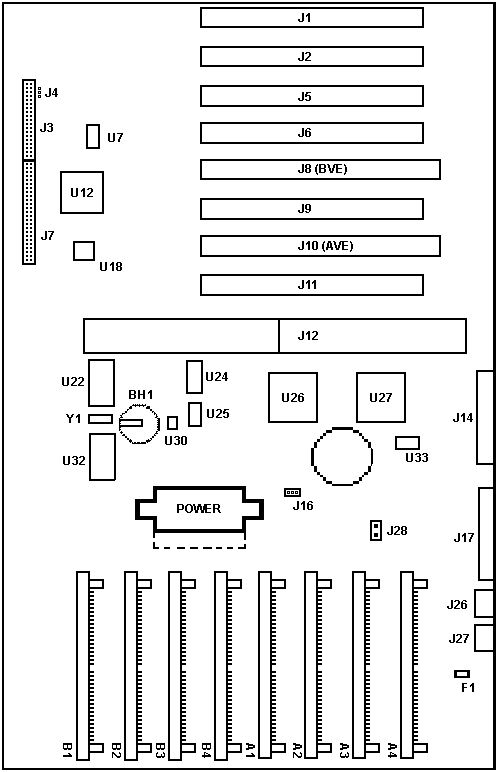|
Model 95 XP 486 System Board

BH1 Battery
F1 Keyboard Fuse
J1, J2, J5, J6, J9, J11 32 bit
slot
J3 Operator
Panel
J4 Unknown
J7 Floppy
Controller
J8 Base Video Extension slot
J10 Auxiliary Video Extension slot
J12 Complex slot
J14 Parallel
J16 JMP1
J17 Serial
J26 Mouse
J27 Keyboard |
J28 Side
Cover Fan
U7 24.0000 MHz Osc
U12 N82077AA
U18 33F5499
U22 SRM2264LC12
U24 20.00000 MHz Osc
U25 14.3181 MHz
U26 85F0464
U27 64F0942
U30 Dallas DS1210
U32 Dallas DS1285
U33 22.1184 MHz Osc
Y1 32.768 KHz Crystal |
8595/9595 Ports
8595 / 9595 Ports

LPT is standard parallel port
COM DB25 serial port capable of
345K
|
8595 / 9595 Operator Panel

|
On the earliest 8595s, the power button has no shutter and
is surrounded by a raised lip. On later models, the power button is covered
with a shutter.
J4 There is no official name, but...
Jim Shorney
During my LED adventures poking around a bad 95 planar,
I decided to investigate the mysterious J4, since it's right next to the
operator panel connector anyway. Seems it was an easy target.
The outer two pins are connected to ground. The center pin is tied
to operator panel
connector pin 29 "-Remote power-on request".
Jim, I followed that pin out a while back. So it goes to remote power
on. OK. What, praytell, is the importance of your find?
Tim Clarke
Well, doesn't it sound as though he's determined
that J4 is the "Wake-On..." header? So, do you just apply 5V for electronic-triggered
power-on?
Um, hadn't thought of that...
The parallel port is NOT ExpressPrint capable...
From the Godfather-
Seriously: the 8595 planar is stage 3 and does not support
the stage 4 "synchrostream mode", which is turned off then. It supports
the normal 64-bits burst mode with up to 40MB/s. So a Type 4 platform will
be significantly slower in an old 8595-type planar than in a Server 95A
planar (the one with the two serial and two parallel ports). The systemboard
controller on the "single-LPT" planars does not return the proper values
on trying to start up the synchro-stream - therefore it is not used. The
only advantage left over is the faster CPU and higher calculation data
throughput - and the ability to run Pentium software (if required). The
overall performance is of course higher compared with e.g. the DX-50 platform
- but it does not even come close to the values achieved with the same
processor card in the 9595A "double LPT"-planar. At least not in a cumulated
/ weighted application which includes combined calculation and I/O traffic
loads.
For information again: The "small" 9595s model -xLx (Type
2) and -xMx (Type 3) had the old planar - all others usually had the 9595A-planar
(Type 4 -xNx, -xPx, -xQx).
Editor's Note: Checked a -xKx and
-xMx planar. Same chipset, same oscillator values. Only difference was
some SMD oscillators replaced metal ones. A few less logic chips. And the
-xLx, -xMx planars are a lovely green.
9595 Main Page
|

